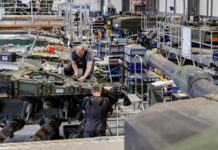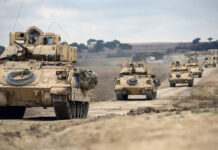A synthetic aperture radar system with the capability to operate in all types of weather, day or night, is one step closer to providing warfighters with high resolution reconnaissance imagery. A recent review has concluded that the Lockheed Martin [NYSE: LMT] Tactical Reconnaissance and Counter-Concealment Enabled Radar (TRACER) system is acceptable for integration onto manned and unmanned aerial platforms.
The Critical Design Review (CDR) focused on the design and integration details associated with the radar’s operation on an unmanned aerial system and concluded that the TRACER podded design is acceptable for use on the Predator B platform. The review was conducted for the United States Army Communications-Electronic Research Development and Engineering Center Intelligence and Information Warfare Directorate (I2WD). This successful CDR paves the way for the first flight of TRACER on an unmanned aerial vehicle scheduled for late summer.
TRACER addresses the Army’s critical need to identify hidden targets, enemy equipment and facilities. Incorporating both a VHF and UHF band within the synthetic aperture radar system, TRACER provides images to ground units in all-weather, day or night conditions. The system also incorporates provisions for a data link that allows airborne processed results to be down-linked to ground stations immediately. The system’s design is predicated on Lockheed Martin’s proven foliage penetration (FOPEN) technology. FOPEN was developed specifically to detect vehicles, buildings, and large metallic objects in broad areas of dense foliage, forested areas, camouflage netting and wooded terrain. It will be able to spot suspicious cavities, which could be used for used for weapon caches in building or underground or explosive charges buried at roadsides. TRACER will able to provide long-range, wide area detection of targets under camouflage, concealment & deception (CC&D) conditions, and support wide area mapping in complex environments.
In 2007 Lockheed Martin has been selected to provide the TRACER capability to the United States Army. Under this contract, Lockheed Martin will work with the Army to incorporate low frequency synthetic aperture radar systems into Predator class unmanned aerial vehicles. The total value of the TRACER contract is approximately $40M.
The 32 months program includes the development, integration and test of two VHF/UHF dual-band synthetic aperture radar systems, which will be integrated into Predator class unmanned aerial vehicles. The system will process raw radar data on-board in near real-time processing change detection and possibly orthorectification to provide accurate geo-location of targets. These dual-band synthetic aperture radars can provide images to ground units in all-weather, day or night conditions and incorporate a data link that allows processed results to be downlinked to ground stations immediately. The TRACER ground station element will provide the target reports, with appropriate time-tag, geolocation and other information.
Developed under the sponsorship of the Defense Advanced Research Projects Agency, the U.S. Army and the U.S. Air Force in the late 1990’s, the FOPEN system has successfully flown hundreds of missions.
















